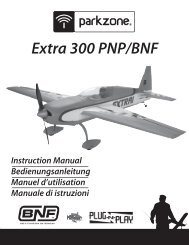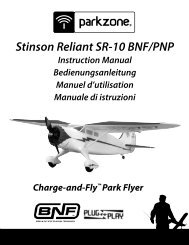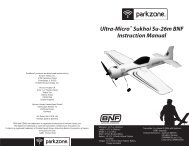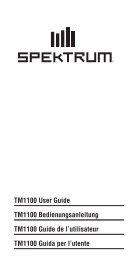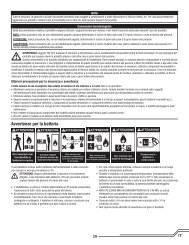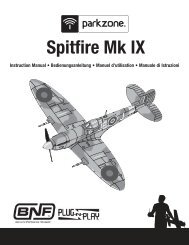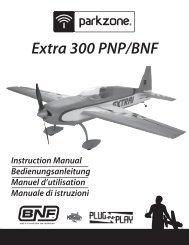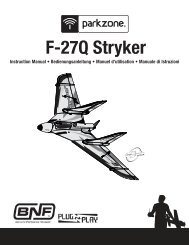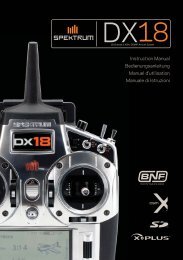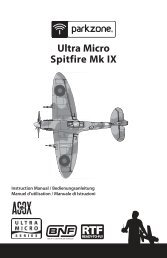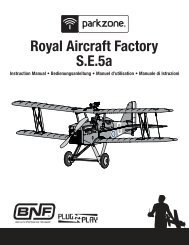Spitfire Mk IIB RTF - Horizon Hobby
Spitfire Mk IIB RTF - Horizon Hobby
Spitfire Mk IIB RTF - Horizon Hobby
Create successful ePaper yourself
Turn your PDF publications into a flip-book with our unique Google optimized e-Paper software.
1. Read and follow this manual completely, observing all<br />
instructions and safety directions. Otherwise, serious<br />
injury and damage can occur. Think about your safety,<br />
and the safety of others, first.<br />
2. Keep the propeller away from body parts and clothing,<br />
even when it isn’t spinning, as it could be turned on by<br />
accident. Beware of hair becoming entangled in the propeller,<br />
especially while launching your plane.<br />
3. Do not fly when it’s too windy or you may lose control<br />
and crash, causing injury or damage. Never fly near<br />
people, vehicles, train tracks, buildings, power lines,<br />
water, hard surfaces or trees. Never allow anyone to<br />
attempt to catch the airplane while it’s in flight or serious<br />
injury may result.<br />
4. Adult supervision for flying and battery charging is recommended<br />
for pilots age 14 and younger.<br />
5. Only use a battery charger that is Ni-MH compatible<br />
to charge the flight battery. Never leave the charger<br />
unattended while charging. This will help prevent overcharging<br />
and make sure damage does not occur to the<br />
battery, charger or any other property. While charging,<br />
1. Don’t fly in winds over 15 km/h! If you are a less experienced<br />
pilot, this is especially important.<br />
2. A pilot who has never flown a 3-channel plane with pitch<br />
control should get help from an experienced radio control<br />
pilot during first flights. Pilots who have not flown<br />
a 3-channel plane at all should not fly unless an experienced<br />
RC pilot is present to guide them.<br />
3. Choose your flying field carefully—grass and soft<br />
ground with a 180-meter diameter of open space is<br />
optimal for flying and will lengthen the life of your airplane.<br />
Make sure there are no obstacles that will get in<br />
your way when flying, such as trees or buildings. Make<br />
sure you do not fly where there are pedestrians who<br />
could be hurt by the airplane.<br />
4. Remember that holding the stick full over for too long<br />
can cause the airplane to spiral dive and crash. At the<br />
very first sign of the plane beginning to spiral down,<br />
immediately release the stick and give the opposite turn<br />
control to the spiral, then pull back on the elevator gently<br />
to level flight and level the wings.<br />
Warnings and Safety<br />
Success Tips<br />
place the battery on a heat-resistant surface. Do not lay<br />
it on carpet or upholstery while charging. If you are using<br />
a Li-Po battery to fly your <strong>Spitfire</strong> <strong>Mk</strong> <strong>IIB</strong>, you will need to<br />
use a Li-Po compatible charger for that battery pack.<br />
6. Never cut into the battery, charger, or airplane wires or<br />
serious injury may occur. Causing the battery to “short<br />
out” (crossing negative and positive bare wires) can<br />
cause fire, serious injury and damage.<br />
7. Hold the plane securely when the flight battery is<br />
plugged in, and keep all body parts away from the<br />
propeller. When you finish flying your airplane, always<br />
unplug the battery before you turn off the transmitter.<br />
8. Never fly on the same frequency as another RC vehicle<br />
in your area. The frequency of the airplane is shown<br />
on stickers on the back of the transmitter and on the<br />
airplane.<br />
9. If you decide to power your <strong>Spitfire</strong> <strong>Mk</strong> <strong>IIB</strong> with a Li-Po<br />
battery, follow the instructions and warnings included<br />
with the battery and charger. ALWAYS unplug and<br />
remove your battery after flying.<br />
5. Don’t attempt to fly or do maneuvers beyond your flying<br />
abilities. Seek the assistance of an experienced pilot<br />
when trying new maneuvers that are more extreme and<br />
involve fast flight.<br />
6. If you’re gliding with the motor off, allow your plane<br />
more area for turns.<br />
7. Position yourself at your flying field so that you keep the<br />
sun at your back and out of your eyes. Wear sunglasses<br />
on bright days.<br />
8. Keep the aircraft upwind, especially on windier days, to<br />
prevent it from “flying away.” The wind is normally stronger<br />
at higher altitudes than it is on the ground.<br />
9. Keep your plane in front of you so you don’t have to<br />
turn in circles as you fly. Try to avoid flying directly<br />
overhead.<br />
1. Lire et suivre entièrement ce manuel, en observant<br />
toutes les règles et conseils de sécurité. Dans le cas<br />
contraire, des blessures ou des dommages peuvent<br />
survenir. Pensez tout d’abord à votre sécurité.<br />
2. Toujours garder l’hélice loin de toute partie de votre<br />
corps, même quand elle ne tourne pas car vous ou une<br />
autre personne peut mettre le moteur en route par accident.<br />
Se méfier de ne pas se prendre les cheveux dans<br />
l’hélice surtout par jour venteux.<br />
3. Ne pas voler quand il y a trop de vent sous peine de<br />
perdre le contrôle de votre modèle et causer un accident<br />
avec des blessures et des dommages. Ne jamais<br />
faire voler le modèle à proximité d’autres personnes, de<br />
véhicules, de routes, de voies ferrées, de bâtiments, de<br />
ligne électriques, de l’eau, de surface dure ou d’arbres.<br />
Ne jamais permettre à quelqu’un d’essayer d’attraper le<br />
modèle en vol sous peine de blessures sérieuses.<br />
4. La présence d’un adulte est obligatoire pour les pilotes<br />
âgés 14 ans ou moins<br />
5. Utiliser seulement un chargeur prévu pour la batterie du<br />
modèle. Ne jamais laisser le chargeur sans surveillance<br />
pendant la charge. Cela permet d’éviter les surcharges<br />
1. La règle pour les débutants : ne pas voler avec un vent<br />
de plus de 15 km/h.<br />
2. Les pilotes n’ayant jamais utilisé un modèle 3 voies<br />
avec contrôle des ailerons doivent se faire assister par<br />
un pilote expérimenté pour les premiers vols.<br />
3. Choisir un champ recouvert d’herbe, en terre meuble et<br />
d’un diamètre de 180 mètres minimum pour voler dans<br />
des conditions optimales et allonger la vie de votre<br />
Modèle.<br />
3. Tenir le manche trop longtemps d’un côté ou de l’autre<br />
peut entraîner le <strong>Spitfire</strong> dans une vrille et causer un<br />
crash. Au premier signe de basculement ou de départ<br />
de vrille, relâcher immédiatement le manche droit ou le<br />
passer dans le côté opposé pour redresser l’aile.<br />
5. Ne pas voler au delà de vos capacités sans l’assistance<br />
d’un pilote expérimenté.<br />
Règles de Sécurité<br />
Conseils<br />
et d’endommager la batterie, le chargeur ou d’autres<br />
éléments. Pendant la charge, placer la batterie sur une<br />
surface thermorésistante. Ne jamais poser la batterie<br />
sur de la moquette pendant la charge. Avec une batterie<br />
LiPo, vous devez utiliser exclusivement un chargeur<br />
spécifique pour ce type de batterie.<br />
6. Ne pas couper ou dénuder les câbles de la batterie,<br />
du chargeur ou de l’avion pour éviter de provoquer un<br />
court-circuit et causer un feu, des blessures sérieuses<br />
et des dégâts<br />
7. Tenir le modèle fermement et garder constamment<br />
la zone de rotation de l’hélice libre de tout obstacle.<br />
Après le vol, toujours débrancher la batterie de propulsion<br />
avant de mettre l’émetteur hors tension.<br />
8. Ne jamais voler sur la même fréquence qu’un autre<br />
pilote. La fréquence de votre modèle est indiquée sur<br />
les autocollants au dos de l’émetteur et sur le côté du<br />
fuselage.<br />
9. Si vous utilisez une batterie Li-Po, suivre attentivement<br />
les instructions fournies avec la batterie et le chargeur<br />
pour éviter tout incident. TOUJOURS sortir et débrancher<br />
votre batterie après le vol.<br />
6. Quand le moteur est coupé, le modèle a besoin de plus<br />
d’espace pour tourner.<br />
7. Se positionner pour avoir le soleil dans le dos et le<br />
modèle fac à vous.<br />
8. Toujours garder le modèle face au vent, surtout quand<br />
ce dernier est important. Se souvenir que le vent est<br />
toujours plus fort en altitude par rapport au sol.<br />
9. Faire évoluer votre modèle devant vous pour éviter de<br />
vous retourner pour le suivre. Essayez d’éviter de voler<br />
directement au-dessus de vous.<br />
40 41



